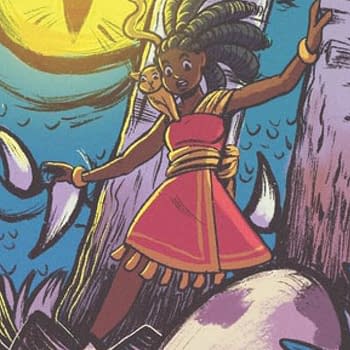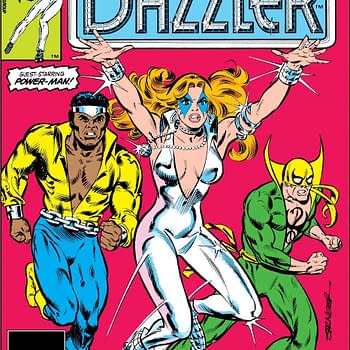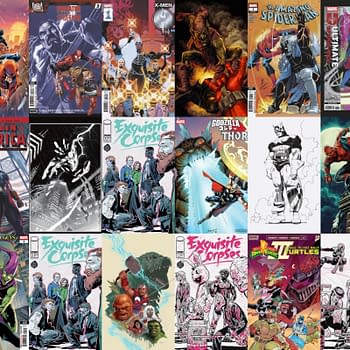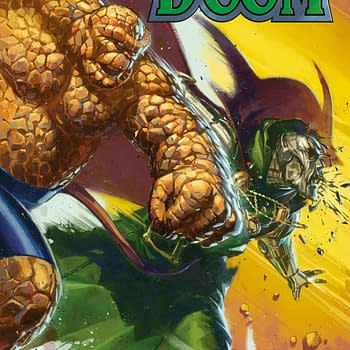Posted in: Comics | Tagged: Comics, idw, joe hill, locke and ket
The New Locke & Key Treasury Edition Is Smarter Than You Think
IDW Treasury Editions are doing well by Joe Hill. First they released his Terrifyingly Tragic Treasury Edition and now Locke & Key has been given a more direct spotlight in its own volume (priced at $9.99 in 8 ½ by 13 inches). IDW's choice of story for the edition was spot-on and the format for the original three issues of the series from the "Crown of Shadows" arc must have made it an obvious stand out for the edition. Not only do issues #3-5 contain some of Gabriel Rodriguez's most memorable artwork in depicting the fluid, shifting shadows that attack the Locke family, but they also contain that tour-de-force, the "giants fighting giants" sequence. That alone presents a total of 12 full page spreads of Tyler Locke grappling Kaiju-like with a conglomerate monster of shadows on sea and land. If you're going to blow up some pages from Locke & Key super-sized, those are surely the ones to pick, though I doubt fans would mind if every page of Locke & Key was presented in a prestige format like this.
But I suspect there was more to the choice of the "Crown of Shadows" arc for the volume than simply the extraordinary art in poster-like layouts. In fact, these three issues have unique qualities that make them an excellent microcosm to represent Locke & Key as a series and illustrate why it has been such a success from its first issue's first-day sell out to its multiple reprints and trade editions. Prestige art editions show off the harmonic balance between Joe Hill's understated but buoyant storytelling and the visual world created by Rodriguez anyway, but these issues show Rodriguez's ability to run wild with fantastic shapes and forms, as well as Hill's neatly structured storytelling that creates an almost orbital structure. In this structure, each main character seems to revolve within their own world while reaching points of overlap or centrifugal pull that keep them in mutual rotation. The center point of their orbit is, in many ways, Key House, but thematically, it is also the youngest member of the Locke family, Bode.
[*Spoilers for issues #3-5 of the "Crown of Shadows" arc contained in the Treasury below]
In issue #3, Ty hunts Bode and seems like a shadowy monster about to overtake him, but in their tussle, the brothers discover another key embedded in the floor of the house, a giant one that seems linked to a large picture window. Ty exclaims, "Jesus, kid, you got to stop finding, like, keys and stuff". Bode's reply is a simple fact that readers of the series would recognize by this point in the storyline, "I don't find them. They find me". If the keys gravitate toward Bode, so does everything else in the story, including other characters.
But Hill wisely breaks away from this gravity to make sure that the full cast of characters receive their due and feed variety into the storyline. Mrs. Locke and Mr. Mutuku get their separate space for a tete-a-tete, and Kinsey and her mother get adequate space to really hash it out over increasing alcoholism. Then we get a neatly separate segment showing Kinsey's developing alternate social life free of the sinister Zach Wells before it all comes back to Bode. These segments are kept short, light, and useful. They make you feel like you know the characters, can see the developments in their personalities, but do not push you too far off the main path that draws you back to the center of the story.
Suitably, Bode is the first to be depicted encountering the newly raised shadows that are poised to take over the house in search of keys. Hill and Rodriguez deserve more than a nod for their amusing reference to the story Peter Pan and Peter's experience of having his shadow sewn back onto his feet by Wendy as Bode's shadow takes on the form of the lost boy. Each of the three Locke offspring are attacked separately by the morphing shadows, giving Rodriguez the opportunity to visually expound on an old, and perhaps by now a little overused horror trope: terrifying statuary come to life. Here, the shadows take on their own statuesque forms, but change at will, shaking up the motif.
As each character encounters the shadows, something we've learned about them earlier in the arc comes into play. Bode loves Peter Pan and associates the story with Tyler spending time reading to him, so Peter is his shadow. Kinsey's attacking shadow is one of the most frightening depicted, suggesting that she has some very deep-seated fears, but her developing relationships break through and come to the rescue for her in the form of her life-preserver flashlight, given to her by her friends. She seizes agency and proceeds to protect Bode. She finds a hero's role on the other side of her fears. Tyler's left with the more humorous silent dialogue with the "Lady of the Well" shadow and doesn't really find it a tall order to deliver snark in response. We know he's brave, so the plot doesn't really reveal much more about his character—yet.
It becomes clear that the gathering, conglomerate shadow-wolf is really after Bode (once again reinforcing his central position in character and plot orbits), leaving Tyler behind to make an informed decision. He realizes that there's not much more he can do aside from resisting. To become active, to become a player in Key House, he has to use something greater than bravery and take a risk on magic. It's a fairly seminal moment for Ty, and one that, of course, makes for great visual storytelling. In a series already full of visual surprises, Locke and Key #4 delivers its biggest shocker not in the Kaiju sequences (though they are stunning) but in the simple three panel page wherein Key House moves from a moonlit silhouette to a fractured bolt of light, and finally, a gigantic doorway itself as the giant Ty steps through. That, in many ways, is the money shot of the Treasury Edition, too, however impressive each full page spread of Ty's battle will become. This is Ty given his moment. He can't keep his mom from drinking. He can't really battle a certain loneliness that seems to follow him, and he can't keep Bode's shadow from coming to life like the pages of a storybook, but he can do this. Unleash some whoop-ass on a monster to whom he has become equally monstrous.
Upon first reading these issues, fans may have been rooting for a little moment of prestige for Tyler, who often labors under the weight of the murder of his father, the disintegration of his mother, and the tension between brotherliness and fatherliness toward Bode. There's nothing complex about his shadow struggle; he just has to take it all down by sheer force of will, and he's in his element, finally. He's mostly silent, too—quipping isn't necessary when he's nose to nose with the dark. The monster doesn't play nice, either. The angled shots of the large spreads emphasize the dirt, water, and strangeholds the monster is using on Ty, but his expression remains the same throughout, like it's all a done deal; there is no way the monster is going to win. Probably the most enlightening character moment for Ty, though, is when he lifts up his now diminutive brother and sister and wants to "show" them "something". "This is home, guys. We're not going to run from shadows here", he says. You can't shake the feeling that Ty has benefited from the fight with the shadow monster much more than he would have spending the night slumped in front of the TV. He needed something to do in order to define himself and he got the opportunity to do so.
As each character receives their own private lives and intersecting moments in issues #3-5, we watch them change slightly, mostly for the better. They return to Bode, and therefore also the keys and the house as their focal point, a point that Ty affirms when he declares it their "home". But the Locke kids have also survived a night on the wild side without parental help, and collectively cover up what really happened that night. It's as if the generations of the Locke family have fully shifted within a couple of issues, and these are the same issues chosen for the Treasury Edition. Coincidence? Maybe it was just the strength of the artwork which recommended these issues, but simply strong art without significant plot elements would have done a disservice to the book. Instead the focus is double, and equal, reminding readers of just what a strong combination of features Locke & Key contains in terms of comics storytelling, and also given the chance to relive some of their favorite visual moments in the series. Will there be more Treasury Editions for Locke & Key? If not, IDW got it right in one shot, and showed some smarts in doing so, but if there are more, any new collections will be defined by comparison to this one as a more or less definitive object lesson in the strengths of Locke & Key as a whole.
Hannah Means-Shannon writes and blogs about comics for TRIP CITY and Sequart.org and is currently working on books about Neil Gaiman and Alan Moore for Sequart. She is @hannahmenzies on Twitter and hannahmenziesblog on WordPress. Find her bio here.
















